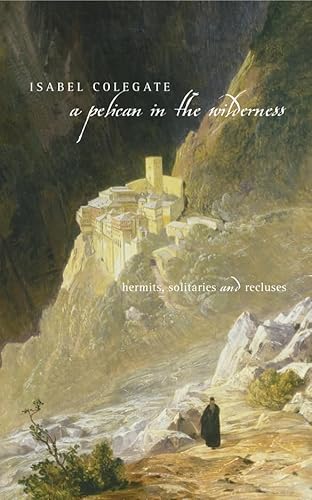Items related to A Pelican in the Wilderness: Hermits, Solitaries and...

‘A man that studies Happiness must sit alone like a Sparrow upon the House Top, and like a Pelican in the Wilderness’ – Thomas Traherne. Celebrated novelist Isabel Colegate explores the lives and works of those who've followed the call of solitude, from Lao Tzu and the Desert Fathers to Wordsworth and Thoreau.
In A Pelican in the Wilderness, Isabel Colegate casts through time and place to uncover tales of human solitude.
The quest for solitude – whether for social, religious, personal or intellectual reasons – dates back to ancient times. As a spiritual phenomenon it has its roots in Chinese, Hindu and Western philosophies; from the mystical Desert Fathers – the most famous of which was St Jerome – who cast themselves out into deserts and wastelands in search of spiritual revelation, to the Celts on Iona and Lindisfarne (who arrived with only onions to live on). Rousseau found solitaries inspirational, (but declared that he would die of boredom if he had to become a hermit himself, a view possibly shared by St Jerome who only managed to stay in the desert for two years).
Hermits and hermitages even used to be a feature of rural and urban England. Sir John Soane had a hermit's cell installed in his house in Lincolns' Inn. At Hawkstone in Shropshire in the 1780s it was reported that a live hermit was seen gazing at a human skull. And in the eighteenth-century it was seen as highly fashionable to place a hermitage in landscaped gardens; an advert would then be placed for a hermit, specifying particular requirements such as a promise not to cut hair, nails or beard. In return the hermit would receive food and a small gratuity. One hermit in Painshill, Surrey was sacked for drinking beer in the village inn.
But of course, recluses, solitaries, hermits, anchoresses (female solitaries) and 'loners' continue to exist to this day, quietly opting to live outside society or living in complete seclusion in wildernesses. Isabel Colegate examines their lives, motivations, self-reflections, writings and the thoughts of present-day urban and rural hermits.
Those who love Colegate's fiction will find all of its virtues here: historical imagination, quicksilver characterization, understated wit, and an eye for the bizarre matched by a power to evoke the sublime.
"synopsis" may belong to another edition of this title.
"a vivid patchwork of visionary lives" -- The Times
In A Pelican in the Wilderness, Isabel Colegate casts through time and place to uncover tales of human solitude.
The quest for solitude – whether for social, religious, personal or intellectual reasons – dates back to ancient times. As a spiritual phenomenon it has its roots in Chinese, Hindu and Western philosophies; from the mystical Desert Fathers – the most famous of which was St Jerome – who cast themselves out into deserts and wastelands in search of spiritual revelation, to the Celts on Iona and Lindisfarne (who arrived with only onions to live on). Rousseau found solitaries inspirational, (but declared that he would die of boredom if he had to become a hermit himself, a view possibly shared by St Jerome who only managed to stay in the desert for two years.)
Hermits and hermitages even used to be a feature of rural and urban England. Sir John Soane had a hermit's cell installed in his house in Lincolns' Inn. At Hawkstone in Shropshire in the 1780s it was reported that a live hermit was seen gazing at a human skull. And in the eighteenth-century it was seen as highly fashionable to place a hermitage in landscaped gardens; an advert would then be placed for a hermit, specifying particular requirements such as a promise not to cut hair, nails or beard. In return the hermit would receive food and a small gratuity. One hermit in Painshill, Surrey was sacked for drinking beer in the village inn.
But of course, recluses, solitaries, hermits, anchoresses (female solitaries) and 'loners' continue to exist to this day, quietly opting to live outside society or living in complete seclusion in wildernesses. Isabel Colegate examines their lives, motivations, self-reflections, writings and the thoughts of present-day urban and rural hermits.
Those who love Colegate's fiction will find all of its virtues here: historical imagination, quicksilver characterization, understated wit, and an eye for the bizarre matched by a power to evoke the sublime.
"About this title" may belong to another edition of this title.
- PublisherHarperCollins
- Publication date2002
- ISBN 10 0002571420
- ISBN 13 9780002571425
- BindingHardcover
- Edition number1
- Number of pages320
- Rating
Buy New
Learn more about this copy
Shipping:
£ 7.97
From Canada to U.S.A.
Top Search Results from the AbeBooks Marketplace
A Pelican in the Wilderness. Hermits, Solitaries and Recluses
Book Description Hardcover. Condition: New. Dust Jacket Condition: New. 1st Edition. First edition hardcover in dust jacket. 284 pp. Sources, index. New/New. Seller Inventory # 263589

